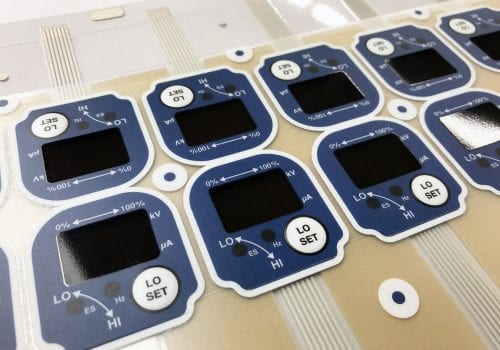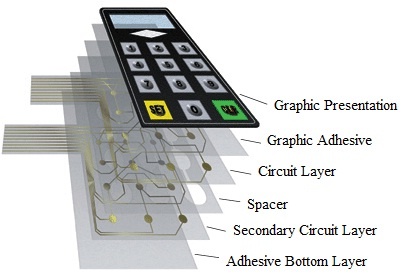The Manufacturing Process Behind Membrane Layer Switch Over: What You Required to Know
The manufacturing process behind membrane layer changes combines cautious design, product choice, and quality control. It starts with recognizing the ins and outs of membrane button style and progresses through numerous stages, consisting of material choices and printing strategies. Each phase plays a necessary role in ensuring capability and longevity. Nevertheless, the complexities of layer building and construction and the extensive testing requirements might reveal understandings that are not right away apparent. What lies past these fundamental aspects?
Recognizing Membrane Change Layout
Although membrane buttons might appear easy at initial glance, their style entails elaborate factors to consider that assure functionality and toughness. The design process begins with a thorough understanding of user requirements, including the user interface's designated application and ecological variables. Comfort designs is a crucial element, as the design needs to assist in convenience of usage while making certain that responsive responses fulfills customer expectations.Moreover, the layering of parts, such as visuals overlays, adhesive layers, and conductive traces, should be exactly engineered. membrane switch. This layered configuration not only affects the button's responsiveness yet additionally influences its long life. Interest is offered to the sealing techniques employed to protect versus dampness and dust, which might compromise performance. In addition, layout factors to consider reach looks, where color pattern and visual clarity boost customer experience. Eventually, the design of membrane switches equilibriums performance, user experience, and durability, making certain that they fulfill the demands of various applications effectively
Products Utilized in Membrane Switch Production
When choosing materials for membrane layer switch production, it is necessary to ponder both performance and resilience. The key materials consist of polyester and polycarbonate films, which give versatility and strength. These films are often covered with adhesive to ensure proper bonding to substrates. Conductive inks, typically composed of silver or carbon, are critical for producing electric connections within the button, permitting trustworthy operation.Additionally, a protective layer, such as a difficult layer, is frequently applied to boost scratch resistance and durability. The selection of backing material, such as acrylic or foam, can significantly influence the button's tactile feel and total customer experience. Numerous ecological factors, including temperature and moisture, must lead material selection to guarantee peak performance in particular applications. Eventually, the appropriate mix of products adds to the membrane button's functionality and lifespan, making informed choices vital for makers.
The Printing Refine: Creating Video and Text
The printing procedure in membrane layer button production plays a substantial duty in generating high-grade graphics and message. Numerous graphic design techniques are employed to guarantee aesthetic allure and capability, while mindful ink option techniques are vital for toughness and efficiency. Comprehending these aspects is essential for attaining finest results in membrane button layout.
Graphic Design Techniques
Graphic layout methods play an important duty in the printing process of membrane layer buttons, as they define exactly how graphics and message will eventually appear on the final item. Efficient visuals design includes the strategic usage of shades, typefaces, and layouts to improve readability and aesthetic allure. Designers usually utilize vector graphics for scalability, making sure that photos continue to be sharp at various sizes. Furthermore, interest to comparison and placement is vital, as it influences user interaction and aesthetic high quality. The unification of branding components, such as logo designs, have to be taken care of with care to maintain brand integrity. Overall, thoughtful graphic design techniques contribute considerably to the functionality and attractiveness of membrane buttons, influencing customer experience and item efficiency.
Ink Option Techniques
Choosing the suitable ink is vital for accomplishing the desired visual top quality and resilience in membrane button manufacturing. Different ink types are utilized, consisting of solvent-based, water-based, and UV-curable inks. Each kind provides distinct characteristics, such as resistance, attachment, and versatility to ecological elements. Solvent-based inks are frequently preferred for their toughness and dynamic shades, while water-based inks are a lot more eco-friendly however may have constraints in bond. UV-curable inks provide fast curing and durable performance. In addition, color matching strategies ensure that the picked inks align with style specifications. Ultimately, the choice of ink have to consider elements such as application technique, substratum compatibility, and end-use demands to attain superior cause membrane layer button graphics and message.
Layer Construction and Setting Up

Product Selection Process
A cautious option of materials is vital in the production process of membrane switches, as it directly affects capability and resilience. The main products made use of consist of polyester, polycarbonate, and various conductive inks. Polyester is typically preferred for its excellent resistance to chemicals and abrasion, making it suitable for severe atmospheres. Polycarbonate, on the various other hand, gives superior clarity and impact resistance, which official website is useful for applications needing presence and effectiveness. Conductive inks, typically composed of silver or carbon, are vital for creating dependable electrical pathways. Additionally, the choice of adhesive products influences the total honesty of the button - membrane switch. Reviewing variables such as ecological direct exposure, responsive comments, and aesthetic requirements overviews suppliers in picking the very best products for their certain applications
Layer Bond Methods
Adhering layers in membrane button building and construction is an essential procedure that ensures functionality and long life. Different bond techniques are used to protect optimal bonding between layers, which typically consist of the usage of adhesives, warm, and pressure. Pressure-sensitive adhesives (PSAs) are generally used for their ease of application and immediate bonding capacities. Furthermore, thermal bonding techniques can be used, where warm is used to turn on glue properties, safeguarding a solid bond. The option of attachment technique largely depends upon the materials included and the specific application requirements of the membrane button. Proper placement and uniform application of adhesives are crucial to stop defects, protecting the button operates successfully throughout its intended life expectancy.
Quality Assurance Steps
Assuring quality control during the layer building and construction and assembly of membrane switches is crucial for maintaining performance and integrity. This procedure generally entails numerous crucial procedures, consisting of comprehensive assessments at each phase of manufacturing. Manufacturers utilize sophisticated screening techniques, such as peel examinations and attachment analyses, to verify the integrity of layer bonds. Furthermore, visual assessments are performed to recognize any kind of issues in printing or product inconsistencies. Environmental conditions, such as temperature and humidity, are thoroughly kept an eye on to ensure suitable healing and attachment. In addition, normal calibration of tools assists preserve exact manufacturing standards. By executing these quality assurance procedures, producers can significantly decrease the risk of item failing, ensuring that the final membrane layer changes satisfy the required requirements and consumer expectations.
Testing and Quality Assurance Procedures

Advancements in Membrane Layer Switch Over Technology
As developments in technology remain to progress, membrane layer switches are taking advantage of innovative developments that improve their functionality and individual experience. One noteworthy advancement is the combination of capacitive touch technology, which permits even more receptive and intuitive user interfaces. This shift not just boosts looks yet also decreases mechanical deterioration, expanding the life-span of the switches.Additionally, developments in graphic overlay materials have actually brought about improved toughness and resistance to ecological elements such as dampness and UV light. These products currently use improved clarity and brightness, more raising the visual appeal.Furthermore, the unification of wise innovation is changing membrane switches right into interactive control panels, making it possible for connection with IoT gadgets. This connection cultivates a seamless user experience, leading the way for applications in different industries, from healthcare to consumer electronic devices. Collectively, these developments position membrane switches over as important components in contemporary device design.
Regularly Asked Concerns
For how long Does the Membrane Layer Switch Manufacturing Process Take?
The period of the membrane switch manufacturing process can vary substantially. Factors such as intricacy, products used, and manufacturing quantity impact timelines, with regular production ranging from a few days to a number of weeks for conclusion.
What Are the Common Applications for Membrane Layer Buttons?
Membrane buttons are frequently made use of in various sectors, consisting of vehicle controls, house appliances, medical devices, and consumer electronic devices (membrane switch). Their flexibility and sturdiness make them suitable for applications requiring easy to use user interfaces and dependable performance in varied settings
Can Membrane Switches Be Personalized for Certain Demands?

What Is the Life-span of a Typical Membrane Switch?
The life expectancy of a normal membrane layer button differs, however usually, it varies from 1 to 5 million cycles. Variables such as use, setting, and worldly top quality substantially affect durability and overall efficiency with time.

Are Membrane Switches Over Eco Friendly?
The environmental kindness of membrane switches differs. Some products utilized might not be recyclable, while others can be green. The general impact relies on producing practices and products, demanding cautious factor to consider during selection and disposal. The production process behind membrane layer switches over combines cautious design, material selection, and top quality control. It begins with understanding the details of membrane button style and progresses with various stages, consisting of material selections and printing techniques. When choosing materials for membrane button manufacturing, it is necessary to contemplate both efficiency and resilience. A cautious selection of materials is crucial in the manufacturing process of membrane layer switches, as it directly affects capability and sturdiness. The selection of adhesion technique greatly depends on the products involved and the certain application needs of the published here membrane switch.